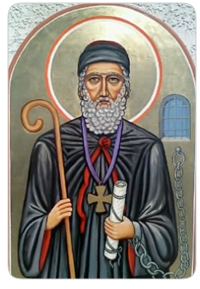Died 552Azerbaijan Feast 28 February | Name Aba I | |
 | ||
Venerated in Assyrian Church of the EastChaldean Catholic ChurchRoman Catholic Church Major shrine | ||
Aba I (or, with his Syriac honorific, Mar Aba I) or Mar Abba the Great was the Patriarch of the Church of the East at Seleucia-Ctesiphon from 540 to 552. He introduced to the church the anaphoras of Theodore of Mopsuestia and Nestorius beside the more ancient liturgical rite of Addai and Mari. Though his tenure as catholicos saw Christians in the region threatened during the Persian-Roman wars and attempts by both Sassanid Persian and Byzantine rulers to interfere with the governance of the church, his reign is reckoned a period of consolidation, and a synod he held in 544 as (despite excluding the Diocese of Merv) instrumental in unifying and strengthening the church. He is thought to have written and translated a number of religious works. After his death in February 552, the faithful carried his casket from his simple home across the Tigris to the monastery of Mar Pithyon.
Contents
Aba is a highly regarded and significantly venerated saint in the Assyrian Church of the East, the Ancient Church of the East, and the Chaldean Catholic Church, which has a seminary in San Diego, California, USA, is named after him. His feast day is celebrated on both the seventh Friday after Epiphany and on February 28.
He is documented in the Ausgewählte Akten Persischer Märtyrer, and The Lesser Eastern Churches, two biographies of Eastern saints.
Early life
Born in a Zoroastrian family of Persian origin in Hala, Mesopotamia. Mar Aba was secretary to the governor of Beth Garmai province before he converted to Christianity, studied, and later taught at the School of Nisibis. Highly regarded as a scholar, he studied Greek in Edessa and is attributed with the translation (or with having overseen the translation) of key texts, including the works of Theodore and Nestorius, from Greek into Syriac. He is also remembered as the author of original works including Biblical commentaries, homilies, and synodal letters.
Commentaries of Theodore
He favoured the Biblical interpretation and commentaries of Theodore of Mopsuestia, at the time a controversial position: the Byzantine emperor Justinian attempted to meet with Mar Aba around 532 (before his installation as patriarch) to persuade him to denounce Theodore's teachings. Justinian was preparing to anathematize Theodore and his works, obviously in sharp opposition to Mar Aba's own views. Acquiescence to Justinian's demands would also have been politically undesirable for Mar Aba, whose Church of the East had secured independence from the Christian west (which Justinian represented) at the Council of Dadisho in 424. Mar Aba was not at the meeting.
544 Synod
Aba's tenure as catholicos followed a 15-year period of schism within the church, during which remote areas had elected their own rival bishops. Aba was able to resolve this schism, visiting the disputed areas and negotiating agreements to reunite the church. In 544, he convened a synod to ratify these agreements; the synod agreed that the metropolitans of those regions under the See of Seleucia-Ctesiphon would, in the future, elect catholicoi at formal meetings. This agreement was, however, substantially subverted in later years, not least when the Persian ruler Khosrau I influenced the selection of Joseph, Aba's successor as catholicos.
The acts of the synod also documented an "orthodoxy of faith", written by Aba himself. Some of its prescriptions indicate the particularly Persian character of the church in the East, including a set of marriage rules prohibiting unions between close kin, apparently formulated in deliberate response to Zoroastrian practice.
Tensions with Persia and Rome
Tensions between the Persian and Byzantine empires ran high during Mar Aba's lifetime, and, after hostilities between the two intensified in the 540s, persecution of Christians in Persia became more common. Zoroastrians hostile to Aba as an apostate pressured Khosrau to act against him, and, as punishment for proselytizing among the Zoroastrians, Aba was placed under house arrest and eventually exiled to Adurbadagan (Azarbaijan). He was allowed to return to the See after seven years and continued as Catholicos until 552, when he died — in some accounts, as a result of torture and exposure inflicted during his imprisonment.
Seminary
The first seminary of the Chaldean Catholic Church outside of Iraq was established in July 2008 in El Cajon, San Diego, as the Seminary of Mar Abba the Great.
